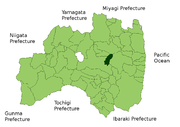Akita clan
For the feudal domain also known as Akita, see Kubota Domain
| Akita clan 秋田氏 | |
|---|---|
|
Map of modern-day Fukushima Prefecture. Miharu, which the Akita clan ruled, is highlighted in green. | |
| Home province | Mutsu Province |
| Parent house | Abe clan |
| Titles | Various |
| Founder | Abe no Sadato |
| Final ruler | Akita Akisue |
| Founding year | 11th century |
| Ruled until | 1873 (Abolition of the han system) |
| Cadet branches | None |
The Akita clan (秋田氏 Akita-shi) was a Japanese samurai clan of northern Honshū that claimed descent from Abe no Sadato. The Akita clan was originally known as the Andō clan (安東氏 Andō-shi). In the Kamakura period, they were installed in the Tsugaru district of Mutsu Province to trade with Ainu people for the Hōjō clan, and to administer Ezo as a penal colony.
In Sengoku period Andō clan was driven out by Nanbu clan, and migrated to neighbor province Dewa. Andō Chikasue changed the clan's name to Akita. It was Akita Sanesue who was the first Akita daimyo during the Edo period. However, Sanesue lost his land and was sent to Shishido in Hitachi in 1602 by the Tokugawa because he performed very poorly during the Sekigahara Campaign.
The Akita survived as daimyo during the Edo period, becoming lords of Miharu Domain (Mutsu Province, 50,000 koku). They were signatories to the pact that formed the Ouetsu Reppan Domei in 1868, but switched sides and assisted the imperial government in subduing the northern domains. After the Meiji Restoration, the Akita, as with all other daimyo, were relieved of office, and their territories were turned into prefectures. Akita Akisue, the last daimyo, was given the title of viscount (shishaku).
References
- (Japanese) "Akita-shi" at Harimaya.com (accessed 18 August 2008)
- Onodera, Eikō (2005). Boshin nanboku sensō to Tōhoku seiken. Sendai: Kita no mori.
- Sasaki, Suguru (2002). Boshin sensō: haisha no Meiji-ishin. Tokyo: Chuōkōron-shinsha.
